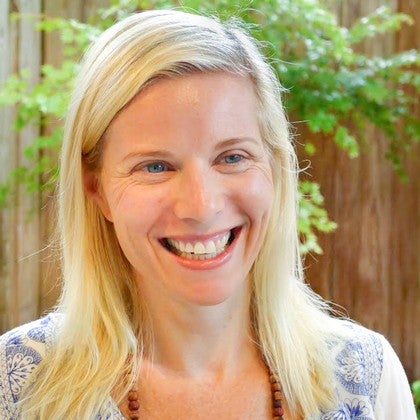
Dancing with My Self: Unpacking the Ego
It’s referenced so often in yoga classes I just assumed I knew what the word meant. Ego - as in egotistical, right? I mentally checked ego off my list as something that I understood and then thought, Now let’s move on to the real yoga teachings.
A murky understanding of the ego is unfortunate because a more refined definition of the ego can quench our yogic thirst. The deepest teachings of yoga are embedded in the subtle understanding of the ego.
Different philosophies have different explanations for the ego so I’ll start by proposing a rather simple definition as the basis for this article: Eckhart Tolle’s definition from his book A New Earth states, “Ego is no more than this: identification with form.”
This definition is like a mandala (which makes it almost intimidating in its oversimplification) because in these few words, the concept of the ego has been distilled into its most concise conceptualization. Upon reflection, we can decipher the more nuanced flavors of this delicacy that is the ego.
So if ego is identification with form, what is form?
In Samkhya Philosophy there are two forces that exist together to create all that is - all that we can sense and all that we know or don’t know.
The two forces are like two sides of a coin – together, but also in opposition - or like the sides of the taijitu symbol (yin-yang) of Taoist wisdom: ever-morphing, constantly seeking balance, consistently merging and dividing. These two forces, blended and yet distinct, are Purusha and Prakriti.
Prakriti is all that is material – “the prime material energy of which all matter is composed”. This includes everything we see and feel and hear and think and taste and smell. Interestingly, our thoughts, as seemingly fleeting and formless as they are, are considered prakriti, and so is our car, our house, the clothes we are wearing (or not wearing), the atmosphere, the trees, the ocean, the flowers, the birds, the bees, our garbage, our bodies. You get my drift, everything. If you can sense it, that is prakriti.
Purusha is consciousness; but don’t let the austerity of this definition dissuade you. It’s much more mystical than words convey. Purusha is not the consciousness that most of us use on a regular basis. Purusha is the highest universal consciousness. Purusha is formless, all pervasive, and imperishable. Purusha and Prakriti together are the duality of Brahma.
So why the duality? Are they both necessary? How do they balance each other?
Try this metaphor: Prakriti, as the vibrant but ephemeral one, dances. If Prakriti didn’t dance, the indestructible and timeless Purusha would have nothing to watch, nothing of which to be conscious. (Sounds pretty boring for Purusha.) Yet, without Purusha, Prakriti would have no reason to dance because there would be no consciousness to witness the dancing.
So what does this have to do with ego?
The ego is when we identify only with Prakriti; we identify only with form; we identify only with what the mind perceives through the senses. We dance without witnessing and we become so absorbed in the dance that we begin to think that the dance is all there is. This, folks, is maya, the illusion. We get absorbed in the trees (we dance with Prakriti) and don’t pull back to see the forest (watch the dance with Purusha).
We identify with our car. Our job. Our heritage. Our body. Our hair color. Our skin color. Our cell phone model. Our Instagram feed. Our culture. Our religion. Ego is when we become chained to our beliefs and refuse to maintain an openness and a curiosity.
When we identify with form we are in shallow water, unaware of the deep current beneath us that is truly creating our “weather” on the surface. Our pride stems from when we feel we have danced well with Prakriti. Our sadness is rooted in the sensation that Prakriti has abandoned us on the dance floor.
So...should we just avoid dancing with Prakriti? I mean, if we dance with Prakriti, we are just setting ourselves up to be seduced by the illusion. And if the ego is when we have been seduced and identify only with the illusion, should we then avoid or attempt to conquer the ego?
In one of Jani Jaatinen’s lectures, he says “Ahamkara (the ego) is not bad, but it is transient, moving all the time.... Remember that there is something beyond the ego. I know how to make distance from the ego. If I am distanced, I can be more stable.”
In this stream-of-consciousness dialogue, Jani doesn’t encourage us to fight or evade the ego, but instead just compels us to keep a safe distance. He calls us to work with the ego, not against. He speaks to the nature of the ego as just that: natural.
Carrying on with our metaphor of the dance, Jani is prodding us to make sure we get off the stage sometimes and sit in the audience. It’s all a performance. Prakriti is dancing. Learn to watch the show – as both the Yoga Sutras and the Bhagavad Gita endorse - with detachment.
Ravi Ravindra says in his lecture when speaking of the ego, “to be free of something does not mean to be against that.” This is liberation! We can let down our guards! There is no need to conquer or even go to battle with our egos. It is part of us and something we must accept.
Frankly, this brings genuine relief for me. The fight was exhausting; I welcome the acceptance. But what’s to be done about the ego? If it’s unavoidable, how do we live in peace with this pestering cosmic roommate?
Madame de Salzman, who was a teacher of Ravi Ravindra, is quoted as explaining that “Ego is a good servant, but a bad master”. For me, this was the key to unlock the egoic quandary. My ego can and should work for me. A useless attendant is not helpful. But I also don’t want the attendant to start calling the shots and telling me what to do. I must maintain my footing by keeping the ego, not as my boss, but as my helper.
A good checkpoint for this – not an easy one, but a helpful one – is to reference Krishna’s advice in the Gita: don’t let the fruits of your actions be the driving force. The ego cares greatly about the fruits of your actions. But the Divine Seed in you, that deepest seed that is calm, that you feel or glimpse or kiss perhaps once and a while in meditation, does not strive. Your deepest seed is not ambitious or driven or worried or sad. How attached are you to the outcomes of your labors? This can be your gauge as to whether the ego is in front of you or behind you.
Erich Schiffmann once gave us homework at a training to pause each hour and just have what he called “a wow moment”. A moment when you stop and remind yourself how trippy “reality” truly is; just a simple pause to pull back and realize that you are on a spinning planet in a vast galaxy and that you – despite the billions upon billions of humans who have walked this earth - have fingerprints that no one else has and that a massive tree can grow from one tiny opportunistic seed.
The ego, in its greatest triumph, is our confidence. With the ego we are compelled to paint our unique brushstroke on the cosmic canvas. As long as that confidence is always watched by the soul and we remember that there is a dance happening, with a partnership of duality, then we can succeed.
The way to keep our egos in check: pause and remember. Take time out of your multi-tasking daily-grind to ponder galactic questions that you may never answer. Living in the mystery of your pondering is enough to pull you out of the ego. Feel the aliveness of the cells of your body. View nature as an existence dancing for your pleasure. Enjoy yourself. Your deepest seed knows that abundance is available and so it does not fear or grasp. As long as you can humbly bow to this deepest seed within you, you will find the balance to live with the ego. You will find the balance both to dance and to witness.
Comments
No comments yet. Be the first!








You need to be a subscriber to post a comment.
Please Log In or Create an Account to start your free trial.